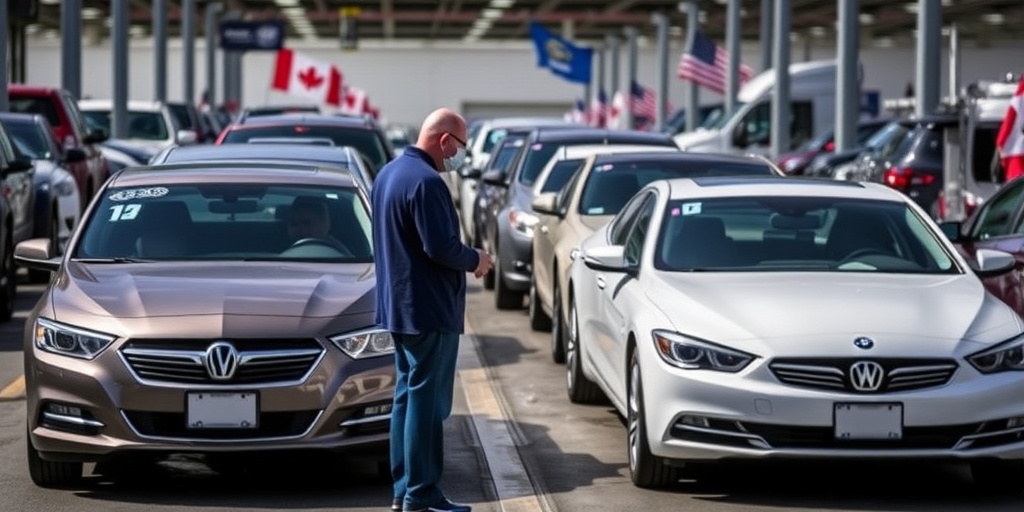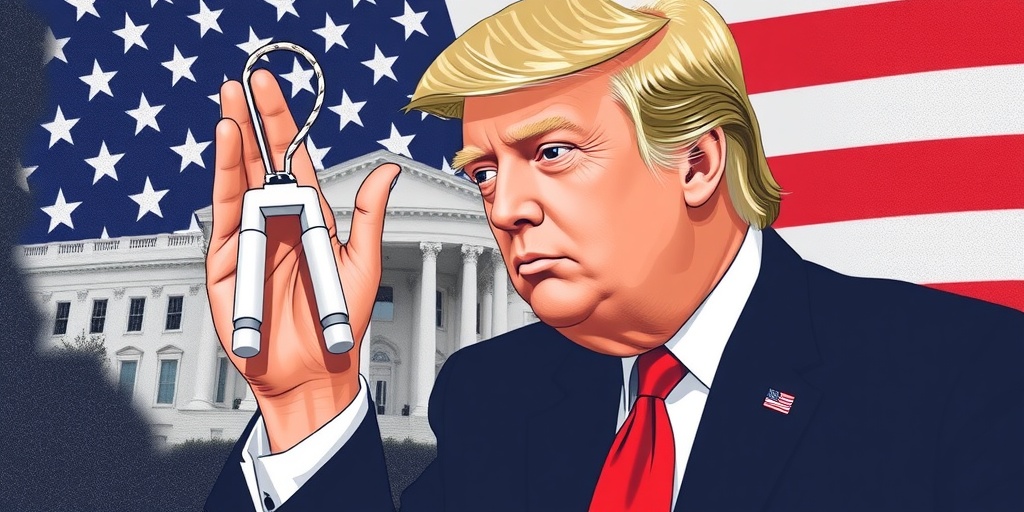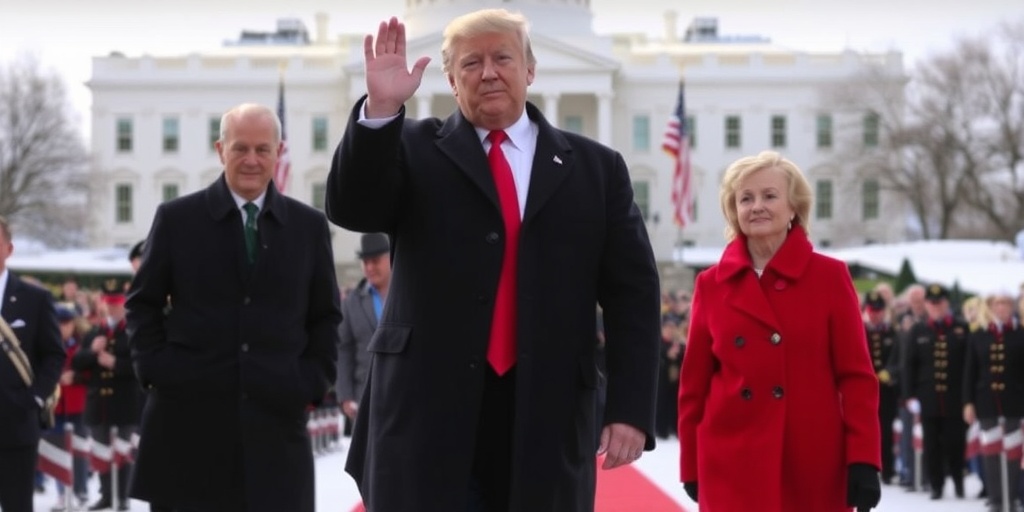Now Reading: Automakers Prepare for Trump’s Tariff Plan on Canada and Mexico
-
01
Automakers Prepare for Trump’s Tariff Plan on Canada and Mexico
Automakers Prepare for Trump’s Tariff Plan on Canada and Mexico

Title: Tariffs on North American Auto Imports: Implications for Industry and Consumers
Automakers engage in the extensive cross-border movement of vehicles and parts between the U.S., Canada, and Mexico, valuing billions of dollars daily. Recently, President Trump’s proposal to implement a 25 percent tariff on imports from these neighboring countries has raised concerns about significant disruptions in the automotive industry. This policy, initiated just hours after his inauguration, is set to formally commence on February 1, leading to a wave of uncertainty throughout the automotive sector. The pressing question now is whether the president will adhere to this plan or if negotiations may offer an alternative resolution.
Industry experts are keenly observing the situation. Mark Wakefield, the global automotive market lead at AlixPartners, pointed out that many in the industry believe this proposed tariff acts more as a negotiation tactic rather than a definitive policy change. "Most people in the industry are waiting to see what happens," he commented, suggesting that the administration’s true intentions, particularly concerning Canada and Mexico, remain unclear at this stage.
Both General Motors (GM) and Ford Motor Company, which have substantial manufacturing operations in Canada and Mexico, have refrained from commenting on the potential impacts of these tariffs. However, the implications of such a tariff are extensive, as both companies transport a considerable number of vehicles and auto parts across the borders.
In theory, the introduction of tariffs is intended to encourage U.S. automakers to shift their production back to the United States, thereby creating new jobs. Nevertheless, the reality of re-engineering cross-border supply chains is fraught with challenges. The current supply chains are optimized to deliver parts to production lines mere hours before installation, making alterations not only complex but also prohibitively expensive. Industry analysts warn that the short-term effects of these tariffs could lead to inflated vehicle prices at dealerships, resulting in diminished consumer demand. This situation may counteract the intended protection of U.S. auto workers, leading to workforce reductions as automakers shrink operations in response to falling sales.
Simon Geale, an executive vice president at Proxima, stated succinctly, "Ultimately what happens is you sell less units and therefore you need less people." The impact of the tariffs will vary significantly based on their implementation. For instance, a 25 percent tariff on a $5 auto part might not be as detrimental, but levying the same rate on a fully assembled vehicle produced in Mexico could trigger an immediate 25 percent increase in retail prices, significantly affecting consumer purchasing behavior. According to Erik Gordon, a business professor at the University of Michigan, higher prices may prompt consumers to delay purchasing new vehicles, thus benefiting repair shops more than car dealerships, where margins are already tight.
The interconnectedness of North America’s automotive manufacturers has evolved over three decades, initially under the North American Free Trade Agreement (NAFTA) and subsequently through the United States-Mexico-Canada Agreement (USMCA) established in 2020. Mr. Wakefield revealed that approximately $150 billion worth of vehicles are traded annually between Canada, Mexico, and the United States. The manufacturing of vehicles in one country can involve multiple crossings of the border for component assembly and final production.
Currently, it is reported that nearly half of the components used in U.S.-made vehicles are sourced from abroad, chiefly from Mexico, Canada, and South Korea. Notably, GM produces 25 percent of its U.S.-market pickups in Mexico and another 15 percent in Canada, while Ford manufactures approximately 12 percent of its pickups in these countries. Stellantis, the owner of popular brands like Jeep and Ram, imports about 40 percent of its pickups from Canada and Mexico. Given that pickups are among the most sought-after and profitable vehicles in the segment, this tariff could significantly alter their market dynamics.
"The industry has operated on the assumption that North America is a free trade zone for decades," Wakefield emphasized. If implemented, a 25 percent tariff would represent a considerable shift for nearly all manufacturers operating within this framework. Automakers experienced tariffs on Chinese imports during both the Trump administration and to a lesser extent under the Biden administration, allowing them to strategize in anticipation of such developments.
Hyundai has adapted to this uncertainty by investing in a $7.6 billion manufacturing complex in Savannah, Georgia, to safeguard itself against shifting governmental policies. The company’s CEO, José Muñoz, noted that substantial domestic sourcing enables their U.S. factories to operate effectively despite potential tariff challenges, stating, "The best solution to avoid any problem is to localize your investments."
The impending decision on tariffs will undoubtedly have profound consequences for the automotive landscape in North America, impacting automakers, consumers, and the broader economy. The resolution of this situation could determine the future of the U.S. auto industry and its labor market, ushering in a new era of operational strategies across borders. As industry stakeholders await clarity from the administration, it remains to be seen how this economic maneuver will unfold and its lasting effects on vehicles and consumer choices.
Stay Informed With the Latest & Most Important News
Previous Post
Next Post
-
 01New technology breakthrough has everyone talking right now
01New technology breakthrough has everyone talking right now -
 02Unbelievable life hack everyone needs to try today
02Unbelievable life hack everyone needs to try today -
 03Fascinating discovery found buried deep beneath the ocean
03Fascinating discovery found buried deep beneath the ocean -
 04Man invents genius device that solves everyday problems
04Man invents genius device that solves everyday problems -
 05Shocking discovery that changes what we know forever
05Shocking discovery that changes what we know forever -
 06Internet goes wild over celebrity’s unexpected fashion choice
06Internet goes wild over celebrity’s unexpected fashion choice -
 07Rare animal sighting stuns scientists and wildlife lovers
07Rare animal sighting stuns scientists and wildlife lovers




















